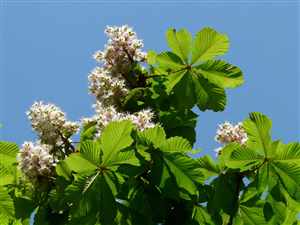Horse Chestnut tree (Aesculus hippocastanum)
Main Facts about Horse Chestnut tree

Using Horse Chestnut tree
According to the results of numerous clinical trials the seed extract of Horse Chestnut tree has been proven to be effective for a short-term treatment of chronic venous insufficiency (CFI), a condition associated with varicose veins, pain, ankle swelling, itching, and nighttime leg cramping. Horse chestnut seed extract is also used to treat hemorrhoids.Horse Chestnut tree is a remedy for: Hemorrhoids
Caution!
Do not take if pregnant. Do not take if you are taking warfarin, aspirin, or other blood thinners. The most commonly cited adverse effects include nausea and stomach discomfort. Other complaints include headache, dizziness, and itching. Rare cases of severe allergic reaction have been reported. Raw Horse Chestnut seeds, leaves, flowers, and bark are poisonous when taken by mouth.| Hops |
Hyssop
|